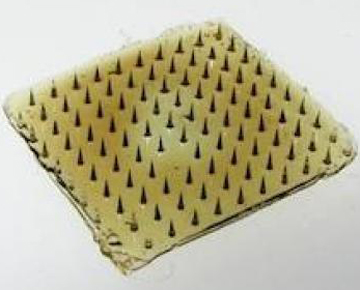
A parasitic worm may hold the answer to keeping skin grafts firmly in place over wounds, according to a new study by HMS researchers at Brigham and Women’s Hospital.
The study was published in the April 16 issue of Nature Communications.
The research team, led by Jeffrey Karp, HMS associate professor of medicine at Brigham and Women’s, invented a microneedle inspired by Pomphorhynchus laevis, a spiny-headed worm that lives in the intestines of fish. The worm securely attaches to the host’s intestinal wall by penetrating the intestinal tissue and then plumping up its elongated, cactus-like head into the tissue.
“Dr. Karp and his collaborators continue to look to nature to find new ways to solve real problems in medicine,” said Scott Somers of the National Institutes of Health’s National Institute of General Medical Sciences, which was a funder of the work. “Drawing on how parasitic worms attach to and feed on fish, they have designed a way to close surgical wounds that appears better than anything currently available for clinical use.”
 Inspired by the worm’s swelling mechanism, senior author Karp and his team created an adhesive patch that mechanically interlocks with tissue through swellable microneedle tips. The tips plump up via a water-based mechanism that is both quick and reversible.
Inspired by the worm’s swelling mechanism, senior author Karp and his team created an adhesive patch that mechanically interlocks with tissue through swellable microneedle tips. The tips plump up via a water-based mechanism that is both quick and reversible.
“The adhesion strength of the tips of the microneedle is more than three times stronger than conventional surgical staples used for skin-graft fixation,” said Seung Yun Yang, HMS research fellow in medicine at Brigham and Women’s and the study’s first author.
Each cone-shaped needle is made of a stiff plastic core and a tip that is rigid in its dry state, but swells upon contact with water. The bed of microneedles penetrates tissue effectively with little force, it maintains continuous, seamless contact with tissue, and it has high adhesion strength when the needles are in their swollen state.
“The unique design allows the needles to stick to soft tissues with minimal damage to those tissues. Moreover, when it comes time to remove the adhesive, compared to staples, there is less trauma inflicted on the tissue, blood and nerves, as well as a reduced risk of infection,” said Karp.
The invention may one day be an alternative to the trauma- and infection-prone staples and sutures used in the operating room to secure skin grafts on patients with serious wounds as a result of burns, infection, cancer or other trauma.
The approach also offers the potential for delivering therapeutics, including proteins. Given its ability to attach strongly to wet tissues, the bio-inspired adhesive microneedles may be broadly applied during internal surgical procedur
|
|
“I envision that this device will be very effective in treating patients, both by skin-graft fixation, but also by delivery of active substances into the surface of the wound. These substances may be, for example, antibiotics, growth-promoting compounds or anti-inflammatory molecules,” said Bohdan Pomahac, HMS associate professor of surgery at Brigham and Women’s, director of both Plastic Surgery Transplantation and the Burn Center at the hospital, and a study co-author.
This research was supported by National Institutes of Health grants GM086433, EB015903 and P41EB015903 and by the National Research Foundation of Korea.
Adapted from a Brigham and Women’s news release.


